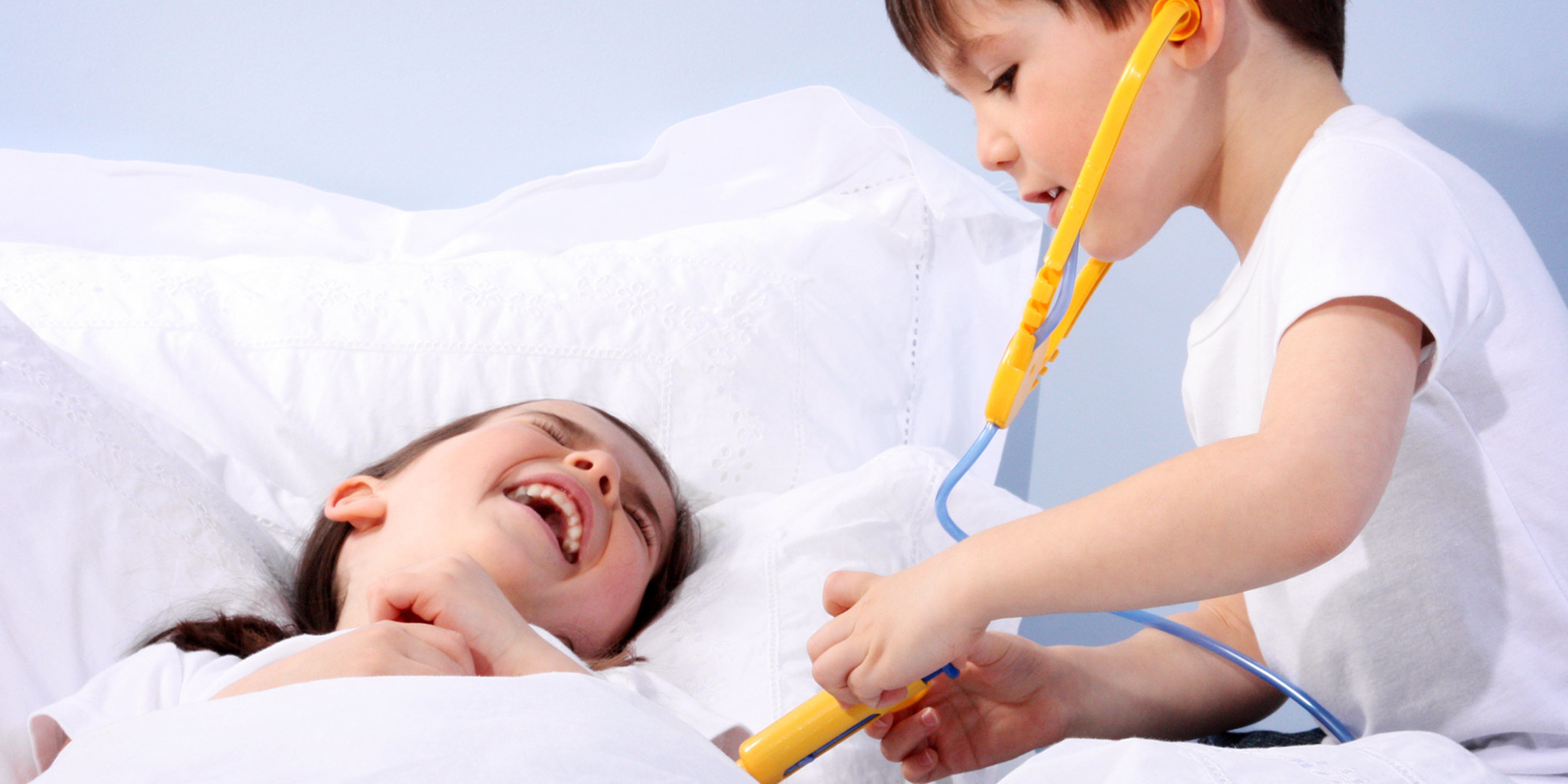Gift lists are endless, filled with this gadget and that “must-have” toy. If you’re looking for something to fill out your gift list, here is an unlikely solution I swear by: A doctor’s kit.
What’s so wonderful about a doctor’s kit?
1. Brain-building imaginative play.
Imaginative play like the kind they’ll do with a doctor’s kit is where it’s at if you want a child who can get along with others, self-regulate, think creatively and solve complex problems. And it’s fun! My girls enjoy a variety of activities, but give them a willing, playful adult and they’ll choose doctoring almost every time. Sometimes they enjoy the opportunity to be in charge as the doctor, while other times they like getting nurtured as the patient. Sometimes they stick to the kit’s contents and sometimes we need a cast (not part of our kit), so they problem solve a stand-in. And best of all, they get to administer shots. Lots and lots of shots. It looks like fun and games, but the benefits of imaginative play are astounding. A wide body of research shows the benefits include self-regulation, the expression and integration of feelings, perspective-taking, organization, social skills, language development, creative thinking, delayed gratification, empathy, cognitive flexibility, problem solving and more.
2. The opportunity to practice deep breathing.
Conscious Discipline is a lifelong practice. I’ve been practicing for almost 20 years and I still don’t have the first skill, Composure, mastered. The most basic piece of the composure puzzle is deep breathing. It’s simple: Three deep breaths help shut off the stress response in the body. But it’s also hard: I grew up internally freaking out instead of breathing during times of stress, so retraining myself to breathe is a challenge. With Conscious Discipline, I get to work on my composure while teaching my girls to do the same. I add deep breathing to our playtime and daily routine so my girls will grow up with a healthier stress response than me. Our doctor’s kit allows lots of opportunities to coach deep breathing.
- “Time to listen to your lungs. Watch your tummy go waaaay out while you breathe in.”
- Broken leg? Deep breaths while we set the bone.
- Need a shot? Pretzel together.
- Sick visit for a bad cough? Deep breath with lots of dramatic, fake coughing.
3. The ability to process a scary situation in a safe and fun way.
Going to the doctor stinks when you’re a kid. You get naked, poked and prodded, and usually get a shot (or two or three). And if you need stitches or a cast, well, that earns you a whole new set of terrors.
At many medical visits, the way to handle the inevitable anxieties, fits and fears involves two or more of the following: “You’re okay,” “It’s not that bad,” physical restraint, “Be a good boy,” “Be a big girl,” “Shush, shush, shush,” and “We’ve got stickers! Don’t you want a sticker?” Imagine going in for an invasive procedure and having someone try any of those approaches with you. Would you feel safe enough to cooperate and calm down or would you continue feeling unsafe and resistant?
I’ll be the first to admit that pre-Conscious Discipline, I may have gone with shushing and holding down the screaming kid while trying to focus her on the sticker treat at the end. But none of these options provide the information, nurturing and sense of safety the child is actually seeking. It’s all brute force and bribery. A doctor’s kit lets kids play and have fun with a scary experience, which play therapists will tell you is a tremendously powerful tool for managing anxiety, fear and traumatic events. Play doctoring can help rewrite the whole family’s script for medical visits, and lets you practice this new script yourself. Here are some helpful Conscious Discipline-friendly tips my family uses while pretend doctoring each other and in the real doctor’s office:
- Active calming through deep breathing and helpful affirmations will help soothe an upset system. Remember to calm yourself first. When they were infants, our internal state (how we feel inside) dictated our baby’s internal state. Our children may be older now, but they still feed off our internal state. When we regulate our state through active calming, we can better help our children become calm. Practice breathing deeply and affirming, “I’m safe, I can handle this,” “You’re safe, you can handle this,” during doctor play. Playful rehearsing now helps both you and your child become more likely to use the new approach in the doctor’s office.When I’m playing the doctor, I coach active calming while giving shots. “Okay, Maddie. It’s time for your shot. It’s going to hurt for a quick second and then it will feel better.” I look deeply into Maddie’s eyes and help her take some belly breaths. “We’re going to take three deep breaths first, and then we’ll do the shot.” Breathe. Pretend shot. More breathing. “There you go, Maddie! You did it! Now you’re safe from the mumps and measles and bumps and weasels.” (At the real doctor’s office, I focus on active calming with her while the nurse administers the shot.)When one of my girls is the doctor, I might put on a scared face and say, “Ten shots! Is it going to hurt? Can we only do nine? What about one big one instead of ten little ones? I feel scared! Can we breathe together?” and encourage her to lead me as the breathing coach. Whether I’m the doctor or the patient, over-the-top acting and unusual afflictions keep the doctoring game interesting.
- Erase “you’re okay” from your vocabulary. We tend to say, “You’re okay,” for nearly everything, but you can be pretty certain your kid’s not okay if he’s throwing a fit, backing away with big scared eyes, hiding, clinging or crying. Instead, honor his experience and offer reassurance by replacing “you’re okay” with “you’re safe” (and lots of deep belly breaths). Use the doctor’s kit to help you practice this simple replacement. In pretend play: “You’re safe. The nurse and I and everyone else at the hospital are here to keep you safe. I’m going to take a look at your broken arm.” In the doctor’s office, breathe deeply and offer various reassuring “you’re safe” messages: “You’re safe. I’ve got you. You can handle this. The doctor’s job is to keep you safe.”
- Validate the child’s experience through empathy. You may think it’s ridiculous for him to be afraid to stick his tongue out and say, “Aaaah,” but your child’s perceptions are different from yours because his life experiences and inner world are different from yours. We sometimes negate, make light of or brush aside children’s feelings because they don’t make sense to us or we don’t know a healthy way to handle them. Feelings that are denied persist; feelings that are accepted can be managed. Empathy accepts the child’s perspective.Empathy sounds like speaking the child’s experience out loud without judgment or joining in: “This is scary for you.” It looks like soft eyes and a gentle, loving expression on your face. It feels like confident comfort: “You are safe.” “You can handle this.” “We’ll get through this together.” Your intention is essential as you say these words; focus on calm reassurance and adding words to his experience instead of just “happying up” your child.
When playing doctor, be present with your child and enjoy! Having fun and connecting is the most important (and most beneficial) part of playing with a doctor’s kit. The secondary goal is to increase your child’s sense of safety and play out healthy ways of managing upset using the quick tips above.
If this approach makes sense to you and you want more information (for pretend play with a doctor’s kit or on an actual doctor’s visit), Conscious Discipline teaches a 5-step self-regulation process that helps adults and children recognize, honor and process our feelings. The five steps are I am, I calm, I feel, I choose and I solve, and the doctoring tips above are all snippets of information that support these steps. Seek out Managing Emotional Mayhem © or the Feeling Buddies Self-Regulation: Toolkit for Classroom / Toolkit for Families to learn more. As for a doctor’s kit, there are dozens to choose from or you can build your own with things like bandages, gauze and cut up socks to serve as casts. My family’s favorite doctoring kit is a B. Wee MD the girls received from a gifter who had no idea the anxiety-reducing power this simple toy would have in our household.




